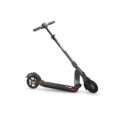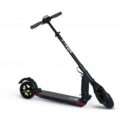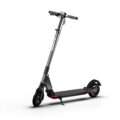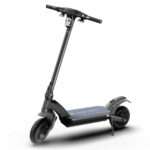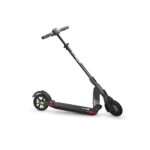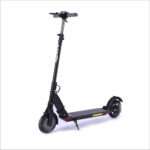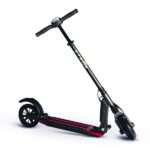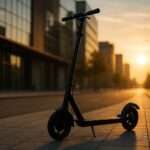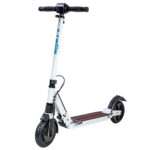- Home
- Scooters
- Electric Scooters
- E-TWOW S2 GT Line
E-TWOW S2 GT Line
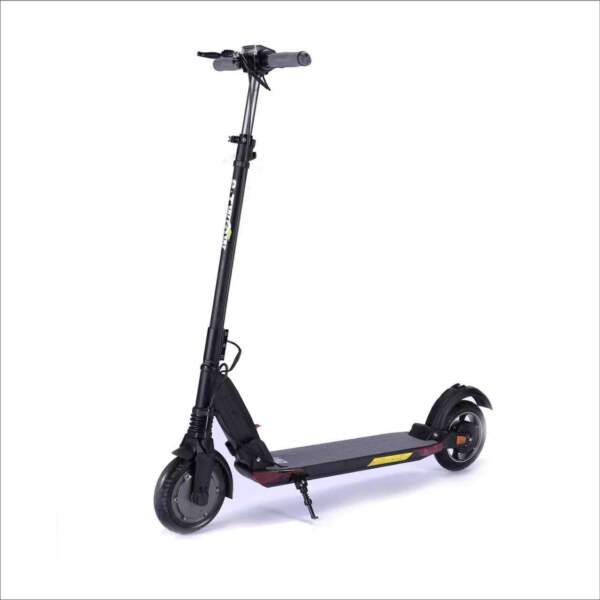


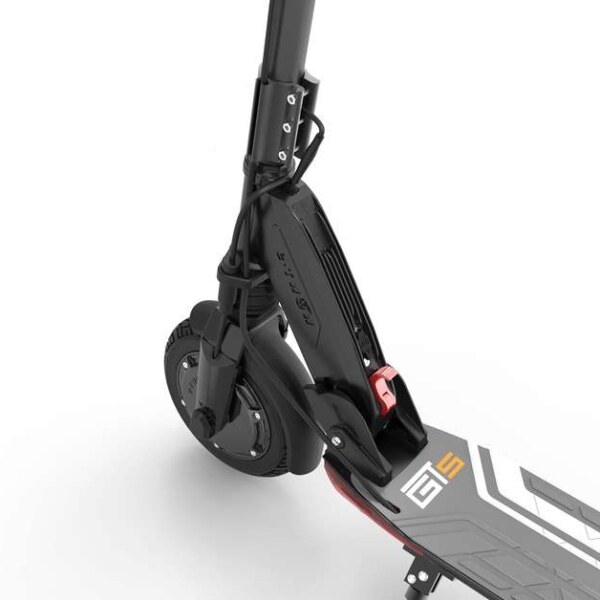
- Battery Range: 25–28 miles (40–45 km)
- Top Speed: 29 mph (46 km/h)
- Motor Power: 500 W
- Weight Capacity: 242 lb (110 kg)
- Charging Time: ~3–4 h
- Scooter Weight: 29.3 lb (13.3 kg)
PROS
- Very light and compact with 3-point folding
- Front regenerative + rear drum braking
- Front & rear suspension for city use
- Bluetooth app with lock and speed-limit controls
- Airless 8″ tires avoid flats
CONS
- Small 8″ solid tires limit comfort
- IP rating not specified
- Narrow deck compared with larger scooters
Key Takeaways
- The E-TWOW S2 GT Line is a lightweight, foldable scooter designed for urban commuting with a 500 W front hub motor.
- It offers three trims: GT SL, GT Sport, and GT Sport X, each with different battery capacities and performance.
- Key features include a compact frame, front electronic regen brake, rear drum brake, and an adjustable handlebar for comfort.
- Range varies from 35 to 45 km depending on the battery pack and riding conditions, with charging time of 3-4 hours.
- This scooter is ideal for city riders and multi-modal commuters but not suited for rough terrain or long uphill rides.
Table of contents
- What Is the E-TWOW S2 GT Line?
- How the E-TWOW S2 GT Line Works
- Key Specifications
- Design & Build Quality
- Performance Fundamentals
- Battery, Range & Efficiency
- Ride Quality & Comfort
- Braking & Safety Features
- Portability & Daily Usability
- Maintenance & Care
- Weather & Seasonal Considerations
- E-TWOW S2 GT Line vs Alternatives
- Who the E-TWOW S2 GT Line Is (and Isn’t) For
- FAQs
- Glossary
- Final Notes on Fit and Setup
The E-TWOW S2 GT Line is a small, quick city scooter. It folds fast, fits tight spaces, and keeps weight low. You get front regen braking, a rear drum brake, and 8-inch solid tires. So daily rides feel simple and low-maintenance.
What Is the E-TWOW S2 GT Line?
This is E-TWOW’s compact commuter family. The frame, wheel size, and cockpit layout stay the same across trims. The E-TWOW GT SL trims weight and charges fast. The GT Sport chases higher speed and a bigger pack. The GT Sport X packs the most energy of the bunch. And every version keeps the core design that made the line popular.
The platform runs an 8-inch wheel format with solid rubber tires. So flats are rare and shop visits drop. A front hub motor rated at 500 W does the pulling. Peak output climbs higher for quick launches. And the light chassis helps it feel eager from the first push.
How the E-TWOW S2 GT Line Works
Picture three parts talking in real time. The right thumb throttle asks for power. The controller meters current. Then the front hub motor turns that into forward motion. Meanwhile, the left thumb lever kicks in the electronic brake up front. A right lever drives the rear drum. Use both and you get clean, steady stops.
Power lives in a 48 V lithium pack. Capacity depends on trim. GT SL carries 7.8 Ah, or about 374 Wh. GT Sport steps up to 9.6 Ah, close to 461 Wh. GT Sport X reaches 10.5 Ah, roughly 504 Wh. The controller, display, and lights share that pack. So smooth pacing pays off on longer days.
A center display shows speed, battery, trip data, and temperature. You can switch modes, set limits, and turn cruise control on or off. Some variants include Bluetooth and the E-TWOW app. Then you can tweak limits, view stats, and lock the scooter.
Key Specifications
These figures describe the S2 GT Line platform and its main variants. Regional limits may vary by seller.
| Block | Details |
|---|---|
| General | Model family: E-TWOW S2 GT Line (GT SL, GT Sport, GT Sport X). Intended use: urban commutes and last-mile hops. Handlebar: height-adjustable with folding grips. Side stand included. Max load: 110 kg (242 lb). Wheel size: 8 in (≈ 200 mm) solid rubber. |
| Performance & Power | Motor: front hub, 500 W nominal, higher peak. GT SL speed: up to 35–40 km/h (22–25 mph). GT Sport/Sport X speed: up to 46 km/h (28.6 mph) when unlocked. Typical climb: short city ramps on clean surfaces. Drive: front wheel. |
| Battery, Charging & Electrical | 48 V lithium. GT SL: 7.8 Ah ≈ 374 Wh. GT Sport: 9.6 Ah ≈ 461 Wh. GT Sport X: 10.5 Ah ≈ 504 Wh. Charger: 54.6 V, 2–3 A. Charge time: about 3–4 hours. Display: color LCD with mode control. Bluetooth/app on select variants. Lights: front and rear LED with side reflectors. |
| Build & Dimensions | Suspension: front and rear spring. Tires: 8 in solid rubber. Frame: compact fold with 3-point system. Folded: ~1060 × 324–330 × 146–150 mm (41.7 × 12.8–13.0 × 5.7–5.9 in). Unfolded: ~1132 × 1075 × 382 mm (44.6 × 42.3 × 15.0 in). Weight: ~13 kg (~28.7 lb). |
| Safety & Control | Front electronic regen brake. Rear drum brake on right lever. Kick-to-start enabled by default. Horn: electric piezo. |
| Features & Extras | Cruise Control (menu P3). Multi-mode speed limiter. Foldable grips. Height-adjustable bar. On BT trims, the app adds speed limit, lock, and unit selection. |
| Warranty & Compliance | Warranty usually runs through the original seller. Many regions offer 24-month legal conformity on core parts with shorter battery terms. Local scooter rules vary by region. |
Design & Build Quality
The frame is tidy and sturdy for its size. The main latch sits above the deck. Flip, press, and the stem folds in seconds. The grips fold too, which trims the width for train aisles and office halls. The adjustable bar helps different heights find a natural stance. And the deck is long enough for a relaxed foot-forward posture.
Solid 8-inch tires and twin springs shape the feel. The ride sits on the firm side on purpose. You skip tubes, patches, and flat fixes. So the scooter spends more time rolling and less time on a bench. The rear drum hides inside the hub, where grit can’t pry at it. And the cable routing stays neat around the cockpit.
Fit and finish beat most budget minis. The display is bright and easy to read. The horn button sits right where your thumb expects it. Brake levers feel smooth and predictable. And the side stand drops down cleanly and holds the scooter steady.
Performance Fundamentals
Starts feel lively. The motor answers the throttle with little delay. So 0–20 km/h comes quick. That helps you clear the line and find your lane next to bikes. The power curve then settles into a calm pull as speed builds.
Straight-line stability is solid on clean roads at city speeds. The wheelbase is short and the deck is narrow. So the scooter turns with small inputs. Bumpy asphalt reminds you the tires are solid. The springs take the buzz out. Big holes still speak up, which is fair for this tire style.
Climbing depends on grade and rider mass. Short 7–10% ramps work at a steady pace. Long climbs slow things as heat and current draw rise. A lighter rider holds speed longer on the same hill. A heavier rider will feel the pace drop earlier. Plan your route with that in mind and carry a steady roll into hills where it’s safe.
Braking is a strong point. The front electronic brake starts the slowdown. The rear drum adds bite and rounds out the stop. Use both levers for short, controlled halts. Practice a few panic stops in a quiet lot. Then your hands will know the sequence when it counts.
Battery, Range & Efficiency
Range changes with pace, weight, wind, and temperature. The GT SL’s 7.8 Ah pack suits short and mid-length commutes. Expect around 35–40 km (22–25 mi) at gentle speeds on flat paths. The 9.6 Ah pack adds a few miles. The 10.5 Ah pack pushes toward 45 km (28 mi) when you ride easy. Treat those as best-day numbers and track your own loop.
Cold weather trims usable capacity. Hot days raise controller and motor temps on long pulls. Headwinds and hills raise consumption. Smooth throttle helps a lot. So many riders sit at 20–25 km/h for efficiency. Coasting into lights beats sprinting, then braking.
Charging from near empty usually takes three to four hours with a 2 A charger. A 3 A unit shortens that window. Charge on a dry, stable surface at room temp. Let the pack cool a bit after a hard ride before you plug in. Then store the scooter indoors to avoid heat swings.
Cruise control helps on long bike paths. Hold a steady speed and it locks in. A light brake tap cancels it. You can turn that feature on or off in the menu.
Ride Quality & Comfort
This scooter rides firm but honest. Solid tires remove flats from your list, yet they pass along some sharp edges. On smooth cycle tracks, the chassis feels settled and quiet. On broken asphalt, bend your knees, shift weight, and float over the rough bits. That stance saves your wrists on longer outings.
Ergonomics are friendly. The bar height adjusts. The deck length leaves room for a turned rear foot. The narrow deck makes quick toe-heel swaps easy when you set up for a stop. The slim stem keeps the front tidy. So you see the road around the display without clutter.
Stem flex stays modest for the weight class. You may feel a touch of twist if you push through fast corners. Keep elbows soft and avoid quick steering at speed. Smooth inputs and early braking make tight paths feel simple. Night rides benefit from that habit too.
Braking & Safety Features
Two systems work together. The front electronic brake slows the motor and recovers a bit of energy. The rear drum delivers a strong, even bite. Use both for the shortest stops. Then practice feathering the left thumb first and squeezing the right lever next. That sequence keeps the chassis planted.
Lighting covers front and rear, with reflectors on the sides. The piezo horn is loud enough for close calls in city noise. The scooter ships with kick-to-start on. So the throttle wakes only after a small push. That prevents surprise jumps at red lights and in crowded entries.
Water protection is for splashes, not streams. Recent variants often carry an IP splash rating. Even so, deep puddles and heavy rain are risky. Electronics and bearings do not enjoy submersion. Slow down if you get caught out. Then dry the scooter before charging.
Portability & Daily Usability
Portability is the headline. The 3-point fold takes seconds. Folded size is roughly 1060 × 324–330 × 146–150 mm (41.7 × 12.8–13.0 × 5.7–5.9 in). Unfolded size is around 1132 × 1075 × 382 mm (44.6 × 42.3 × 15.0 in). Weight hovers near 13 kg (28.7 lb). So one-hand carries up short stairs are realistic. Train transfers stay easy during rush hour.
The folded package slides under a desk or into a trunk. Folded grips help with tight shelves and overhead racks. The side stand works best on level ground. On soft dirt, lean the rear tire against a curb or wall for stability.
For security, lock through the rear wheel and frame when you can. Indoors, pick a fixed anchor. Outdoors, keep stops brief. The scooter is light and easy to lift. So treat street parking like a short errand, not an all-day plan. A hidden ID mark on the frame can help with recovery.
Maintenance & Care
Set a simple five-minute weekly routine. Then stick with it.
- Before rides: Squeeze both brakes. The rear lever should catch early and feel smooth. Scan the tires for cuts or chunking. Solid rubber wears slowly, yet it still ages.
- Fasteners: Check the folding latch, stem clamp, axle nuts, and brake hardware every couple of weeks. Snug is enough. Recheck after the first ten rides.
- Drivetrain: Keep the hub and cockpit clean. Skip the hose. Use a damp cloth and dry everything afterward.
- Brake service: If stops take longer or the lever travel grows, the drum may need adjustment or pads. A quick service visit fixes both.
- Battery habits: Store at about 50–70% for long breaks. Avoid leaving the pack full for many days. Let it cool a bit before charging after hard rides.
- Firmware and app: If your trim has Bluetooth, check for updates. Set speed limits that match your local rules and comfort.
Weather & Seasonal Considerations
Wet roads need extra margin. Solid tires trade grip for durability. Paint lines, metal plates, leaves, and wet stone get slick. Brake earlier than usual and keep the scooter upright through turns. If the rain turns heavy, stop and wait it out. Chargers are indoor tools only.
Cold weather cuts range. Expect a clear drop below 10 °C (50 °F). Plan shorter routes and store the scooter indoors. Heat works the other way. Long climbs on hot days raise temps. So add short cool-down breaks. In winter, wipe road salt from wheels and deck. Then dab a little lube on exposed bolts to keep rust away.
E-TWOW S2 GT Line vs Alternatives
Against bigger commuters, the GT Line saves time at every door. It folds faster. It fits smaller gaps. And it weighs much less than most long-travel scooters. That matters if you stack bus, tram, and train in a single trip.
For a tougher budget commuter that still keeps daily costs low, the Hiboy S2 Pro is a common yardstick. It rides a bit firmer and weighs more, but it brings a longer deck and familiar brakes.
Against heavier “performance commuters,” this scooter gives up suspension travel, tire volume, and rough-road speed. It wins on carry weight, charge time, and storage. So it shines in flat cities with smooth lanes and short distances. If your route is broken and long, a larger chassis suits better.
Against off-road rigs, the GT Line is the city tool. It launches fast, folds small, and needs little care. It does not have knobby tires or long forks. Pick the right terrain and this scooter pays you back with quiet, simple ownership.
Who the E-TWOW S2 GT Line Is (and Isn’t) For
Great fit for:
- City riders with short to mid-length routes
- Students and office workers who need under-desk storage
- Multi-modal commuters who hop trains and buses
- Riders who want flat-free tires and low upkeep
Not ideal for:
- Rough roads where plush travel matters more than weight
- Long suburban rides with many steep hills
- Wet climates that force frequent rain rides
If you ride year-round, add bright outerwear and good gloves. Small reflective stickers on the deck sides help at dusk. Refresh them each season as they fade.
FAQs
How fast does the E-TWOW S2 GT Line go?
GT SL reaches up to 35–40 km/h (22–25 mph). GT Sport and Sport X can hit up to 46 km/h (28.6 mph) when unlocked. Local settings may cap speed, so check before your first ride.
What is the real-world range?
Plan on about 32–45 km (20–28 mi) based on pack size, pace, rider weight, wind, and temperature. Lower speeds on flat paths stretch range the most.
Does it have cruise control?
Yes. Hold a steady speed to set it. A light brake tap cancels it. You can turn the feature on or off in the menu.
What brakes does it use?
A front electronic brake with energy recovery and a rear drum brake. Use both for the shortest, most stable stops.
Is the scooter water-resistant?
It is splash-resistant on recent trims. Deep puddles and heavy rain are still a risk. Slow down in the wet and dry the scooter before charging.
What does the “E-TWOW S2 GT Line overview” cover?
It explains the platform, the variants, core specifications, ride feel, and basic care. Then it helps you judge if the scooter fits your commute.
What is the warranty like?
Coverage usually runs through the seller and region of purchase. Many markets give two years on core parts with shorter battery terms. Keep your proof of purchase.
Glossary
Amp-hour (Ah). Battery capacity measure used to estimate range.
Watt-hour (Wh). Battery energy. Voltage times amp-hours.
Controller. The board that meters power to the motor.
Regen. Regenerative braking that slows the motor and recovers energy.
Kick-to-start. Safety feature that needs a push before the throttle works.
Stem flex. Small bending of the steering tube under load.
IP rating. Dust and water ingress code.
Peak power. Short bursts above nominal output.
UBHI interface. E-TWOW’s handlebar display and buttons.
Drum brake. Brake shoes pressing inside a hub-mounted drum.
Solid tire. Airless rubber tire that trades grip for zero flats.
Thumb throttle. Right-hand lever that sets motor power.
Mode. Speed or power setting in the display.
Zero start. Another name for kick-to-start.
Side stand. Fold-down leg used to park.
Final Notes on Fit and Setup
Pick the trim that matches your route. If your rides are short and flat, the GT SL keeps weight down. If you want more speed and buffer, pick GT Sport or GT Sport X. Set bar height so your elbows have a slight bend. Then practice a few stops in an empty lot. A small hex key in your bag helps with quick checks.
Simple Setup Checklist
- Snug the folding latch and stem clamp after the first ten rides
- Set speed limits that match your comfort and local rules
- Toggle cruise control to match your route
- Hold a steady pace on long paths to save energy
- Charge indoors on a dry, level surface
- Store around 50–70% if you take a long break
Specifications
General
| Model The Model specifies the exact version or name of the scooter. It helps identify its unique design, features, and specifications within the manufacturer’s product line. Knowing the model makes it easier to compare options, find compatible accessories, or look up support information. | S2 GT Line |
| Brand The Brand identifies the manufacturer or company that designs and produces the scooter. A trusted brand is a sign of quality, reliability, and good customer support. Well-known brands often have higher standards for safety, performance, and after-sales service, giving you more confidence in your purchase. | E-TWOW |
| Release Date The Release Date indicates when the scooter model was officially launched on the market. This helps you know how current the design, technology, and features are. A newer release date often means updated components, improved performance, and the latest safety or smart features. | 18 November 2025 |
| Recommended Age Recommended Age indicates the minimum age range that the scooter is designed for, based on safety, size, and ease of use. Following the recommended age helps ensure that riders can handle the scooter’s speed, weight, and controls comfortably and safely. Always check local laws and use protective gear, especially for younger riders. | 18+ |
Performance & Power
| Motor Power (Wattage) What it means: The motor power, measured in watts (W), shows how strong the scooter’s electric motor is. Why it matters: Higher wattage usually means better acceleration, more torque, and improved performance on hills or rough terrain. For example, a 250W motor is good for flat city roads and light riders, while a 500W or 1000W motor provides more power for faster speeds or climbing steep inclines. | 500 W front hub BLDC (700 W peak) |
| Top Speed The Top Speed indicates the maximum speed that the scooter can reach under optimal conditions. It’s usually measured on level ground with a fully charged battery and an average rider weight. A higher top speed allows you to travel longer distances faster, but always ensure you ride within legal speed limits and your personal comfort zone for safety. | 29 mph (46 km/h). may be limited by region |
| Battery Capacity Battery Capacity refers to the total amount of energy the scooter’s battery can store, usually measured in ampere-hours (Ah) or watt-hours (Wh). A higher battery capacity means you can ride longer distances on a single charge, reducing the need for frequent recharging. Keep in mind that actual range can vary depending on rider weight, terrain, speed, and weather conditions. | Not specified |
| Estimated Range per Charge The Estimated Range per Charge indicates the average distance the scooter can travel on a single full battery charge. This range is calculated under optimal conditions, such as flat terrain, moderate speed, and average rider weight. Real-world range may vary depending on riding style, terrain, weather, and load. A longer range means fewer recharges and greater freedom for longer trips. | 25–28 miles (40–45 km) |
| Hill Climb Ability Hill Climb Ability describes the maximum incline or slope that the scooter can handle while maintaining stable performance. It’s typically expressed as a percentage or in degrees. A higher hill climb rating means the scooter can tackle steeper hills without losing too much speed or power. Actual climbing performance may vary based on rider weight, battery charge, and terrain conditions. | 25% grade (manufacturer) |
| Drive System The Drive System refers to how power from the motor is delivered to the wheels. Electric scooters typically use either a hub motor (directly integrated into the wheel) or a chain/belt drive system. A high-quality drive system ensures smooth acceleration, efficient power transfer, and low maintenance. The choice of drive system affects performance, noise level, and overall ride experience. | Front hub (FWD) |
Charging & Electrical
| Charging Time Charging Time indicates how long it takes to fully recharge the scooter’s battery from empty to 100% using the standard charger provided. Faster charging means less downtime and more time on the road. Actual charging time may vary slightly depending on battery capacity, charger output, and environmental conditions. | Approx. 3–4 hours |
| Battery Type Battery Type refers to the specific technology used in the scooter’s battery, which affects performance, lifespan, weight, and charging time. Most modern electric scooters use high-quality lithium-ion (Li-ion) batteries because they offer a good balance of energy density, durability, and low maintenance. A reliable battery type ensures consistent power delivery and longer riding ranges. | Lithium-ion pack with Smart BMS |
| Removable Battery A Removable Battery means the battery pack can be easily detached from the scooter for convenient charging and replacement. This feature allows you to charge the battery separately, swap it with a spare for extended range, or securely store it indoors in extreme weather. Removable batteries add flexibility and make it easier to keep your scooter powered up wherever you are. | Non-removable internal battery (fixed pack) |
| Regenerative Braking Regenerative Braking is an energy-saving feature that converts some of the energy normally lost during braking back into battery power. When you slow down or brake, the motor works in reverse to generate electricity, which helps extend the scooter’s range and improves overall efficiency. This system also reduces wear on traditional brake components, leading to lower maintenance over time. | Yes (electromagnetic regenerative brake) |
| Lighting Lighting refers to the built-in front and rear lights that enhance visibility and safety when riding in low-light conditions or at night. Good lighting helps you see the road ahead and ensures that other road users can see you. Many scooters include LED headlights, taillights, and sometimes brake lights or side reflectors for added safety and compliance with local traffic regulations. | LED headlight + rear LED/brake + side reflectors + electronic horn |
Build & Dimensions
| Scooter Weight Scooter Weight refers to the total weight of the scooter when fully assembled, including the battery. This affects how easy it is to carry, lift, and store the scooter when not in use. A lighter scooter is more portable and convenient for commuting, especially if you need to carry it upstairs or onto public transport. Keep in mind that a sturdy frame and quality components may add to the weight but also contribute to better durability and ride stability. | 29.3 lb (13.3 kg) |
| Maximum Rider Weight Maximum Rider Weight indicates the highest rider weight that the scooter is designed to safely support while maintaining optimal performance and stability. Staying within this limit helps ensure reliable acceleration, braking, and climbing ability, and it protects the frame, suspension, and motor from excessive strain. Exceeding the recommended limit may reduce performance and increase wear on components. | 242 lb (110 kg) |
| Deck Size Deck Size refers to the dimensions of the scooter’s standing platform. A wider and longer deck provides more foot space, allowing you to stand comfortably and adjust your stance while riding. A well-sized deck improves balance and stability, especially on longer rides or at higher speeds. Compact decks, on the other hand, help keep the scooter lightweight and portable. | Long, low deck. folding handlebars |
| Handlebar Height Handlebar Height refers to the distance from the deck to the handlebars, which affects your riding posture and comfort. An appropriate handlebar height helps you maintain good balance, reduces strain on your back and arms, and makes steering more comfortable. Some scooters have adjustable handlebars to fit riders of different heights, while others have a fixed height for a streamlined design. | Adjustable (two positions) |
| Folding Mechanism The Folding Mechanism describes how easily and securely the scooter can be folded for carrying and storage. A well-designed folding system lets you quickly collapse the scooter into a compact size, making it convenient to transport on public transit, store under a desk, or fit into a car trunk. Look for sturdy latches and safety locks to ensure the scooter stays firmly in place when folded or unfolded. | Patented 3-point quick fold with latch |
| Dimensions Folded Dimensions indicate the size of the scooter when it’s fully folded. This measurement shows how much space the scooter will take up when stored or carried, making it easier to check if it will fit in your car trunk, under a desk, or in a closet. Compact folded dimensions are ideal for commuters who need to bring their scooter on public transport or store it in tight spaces. | Folded: 41.7 × 12.8 × 5.9 in (1060 × 324 × 150 mm). Unfolded: 44.6 × 42.3 × 15.0 in (1132 × 1075 × 382 mm) |
| Material Material refers to the primary construction materials used for the scooter’s frame and key components. High-quality materials like aircraft-grade aluminum, reinforced steel, or durable composites provide strength, stability, and a lighter overall weight. A sturdy material ensures the scooter can handle daily wear and tear while maintaining safety and performance. | Aluminum alloy |
Safety & Control
| Brake Type(s) Brake Type(s) describe the braking systems the scooter uses to help you slow down or stop safely. Common brake types include mechanical brakes (like drum or disc brakes), electronic brakes, and foot brakes. Many scooters combine multiple braking systems for added safety and shorter stopping distances. The type and quality of brakes affect your control, especially when riding at higher speeds or on slopes. | Front electronic regenerative + rear drum |
| Suspension Suspension refers to the system that absorbs shocks and vibrations while riding, providing a smoother and more comfortable ride over uneven or rough surfaces. Scooters may have front suspension, rear suspension, or dual suspension for better shock absorption and stability. Good suspension helps reduce rider fatigue and improves control, especially when riding on bumpy roads or off-road paths. | Front & rear suspension |
| Tire Type Tire Type refers to the kind of tires the scooter uses, which directly affects ride comfort, traction, and maintenance. Common types include solid (airless) tires, pneumatic (air-filled) tires, or hybrid options. Pneumatic tires offer better shock absorption and a smoother ride on rough surfaces, while solid tires are puncture-proof and require less upkeep. The right tire type helps ensure safe handling and a comfortable ride in different conditions. | 8″ airless solid tires |
| Tire Size Tire Size indicates the diameter and width of the scooter’s tires, which affect ride comfort, stability, and how well the scooter handles different terrains. Larger tires generally offer better shock absorption and a smoother ride over bumps and rough surfaces, while smaller tires keep the scooter lighter and more portable. Choosing the right tire size helps ensure a balance between agility and comfort. | 8-inch |
| Kickstand The Kickstand is a built-in stand that allows you to park your scooter upright when it’s not in use. A sturdy kickstand keeps the scooter stable and prevents it from tipping over, protecting it from scratches and damage. It also makes storing and accessing your scooter more convenient, whether you’re at home, work, or on the go. | Side kickstand |
| Water Resistance Rating Water Resistance Rating indicates how well the scooter is protected against water and moisture, usually shown as an IP (Ingress Protection) rating. This rating helps you understand whether the scooter can handle light rain, splashes, or wet roads without damage. While most scooters are not fully waterproof, a good water resistance rating adds peace of mind when riding in changing weather conditions. Always avoid deep puddles or submerging the scooter to protect its electrical components. | Not specified |
Features & Extras
| Display/Console The Display (or Console) shows important real-time information about your ride, helping you monitor your scooter’s status at a glance. Typical displays show speed, battery level, distance traveled, and riding mode. Some models also include additional features like Bluetooth connectivity, app integration, or backlighting for better visibility at night. A clear and easy-to-read display enhances safety and convenience on every trip. | Color LCD (30 × 26 mm) with speed, battery, trip/odo, temp, status icons |
| Ride Modes Ride Modes refer to the different speed and power settings you can choose to match your riding style or road conditions. Common modes include eco for maximum range and energy efficiency, standard for everyday balance, and sport or turbo for higher speed and stronger acceleration. Switching between ride modes allows you to customize performance, conserve battery, and ride safely in various environments. | Regular/Sport (via app speed-limit profiles) |
| Smart App Connectivity Smart App Connectivity lets you pair your scooter with a dedicated mobile app via Bluetooth. Using the app, you can monitor real-time ride stats like speed, battery level, and range, adjust settings such as ride modes or cruise control, lock the scooter for added security, and sometimes receive firmware updates. This feature adds convenience and allows you to personalize your riding experience right from your smartphone. | E-TWOW Connect app. set speed limit, lights, Zero Start, lock |
| Anti-Theft System The Anti-Theft System helps protect your scooter from unauthorized use or theft. This feature can include built-in alarms, electronic motor locks, GPS tracking, or remote locking through a mobile app. A good anti-theft system provides peace of mind when parking your scooter in public spaces, adding an extra layer of security to safeguard your investment. | App lock |
| Cruise Control Cruise Control allows you to maintain a steady speed without continuously holding the throttle. This feature makes longer rides more comfortable by reducing hand fatigue and providing a smoother, more relaxed riding experience — especially on flat, open roads or bike lanes. For safety, cruise control can usually be easily activated or deactivated while riding. | Yes (cruise control available) |
| Accessories Included Accessories Included lists the additional items that come with the scooter to enhance your riding experience and convenience. Common accessories may include a charger, kickstand, bell, lights, phone holder, or carrying strap. These extras add value by making your scooter safer, easier to use, and ready to ride straight out of the box. | Scooter, charger (54.6 V / 2 A or 3 A), tools, manual |
Warranty & Compliance
| Warranty Period The Warranty Period indicates how long the manufacturer guarantees the scooter against defects in materials and workmanship under normal use. A good warranty provides peace of mind, showing the brand’s confidence in its product quality. Always check what parts are covered, such as the frame, battery, and motor, and follow the maintenance guidelines to keep your warranty valid. | 12 months (region-dependent) |
| Certifications Certifications confirm that the scooter meets specific safety, quality, and environmental standards set by recognized organizations or regulatory bodies. Common certifications may include CE, RoHS, UL, or other local compliance marks, depending on your region. These certifications ensure that the scooter is manufactured to high standards and is safe and legal to use in your country. | Local micromobility compliance |


